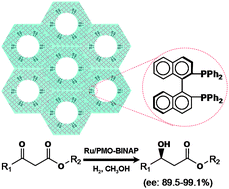Chirally functionalized mesoporous organosilicas with built-in BINAP ligand for asymmetric catalysis†
Abstract
The chirally functionalized periodic mesoporous organosilica (PMO) with C2-symmetric chiral building blocks, BINAP (

* Corresponding authors
a
State Key Laboratory of Catalysis, Dalian Institute of Chemical Physics, Chinese Academy of Sciences, 457 Zhongshan Road, Dalian, China
E-mail:
yangqh@dicp.ac.cn
Fax: +86 (0)411 84694447
Tel: +86 (0)411 84379552
b Graduate School of the Chinese Academy of Sciences, Beijing, China
The chirally functionalized periodic mesoporous organosilica (PMO) with C2-symmetric chiral building blocks, BINAP (

 Please wait while we load your content...
Something went wrong. Try again?
Please wait while we load your content...
Something went wrong. Try again?
P. Wang, X. Liu, J. Yang, Y. Yang, L. Zhang, Q. Yang and C. Li, J. Mater. Chem., 2009, 19, 8009 DOI: 10.1039/B913808K
To request permission to reproduce material from this article, please go to the Copyright Clearance Center request page.
If you are an author contributing to an RSC publication, you do not need to request permission provided correct acknowledgement is given.
If you are the author of this article, you do not need to request permission to reproduce figures and diagrams provided correct acknowledgement is given. If you want to reproduce the whole article in a third-party publication (excluding your thesis/dissertation for which permission is not required) please go to the Copyright Clearance Center request page.
Read more about how to correctly acknowledge RSC content.
 Fetching data from CrossRef.
Fetching data from CrossRef.
This may take some time to load.
Loading related content
